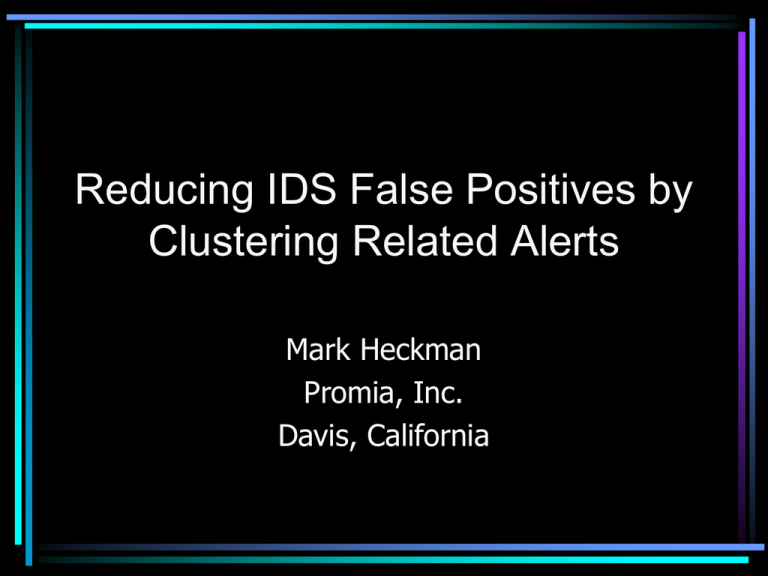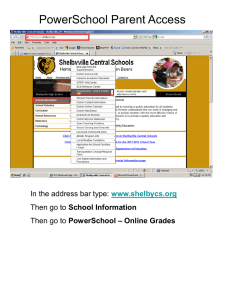Reducing IDS False Positives by Clustering Related Alerts Mark Heckman Promia, Inc.
advertisement

Reducing IDS False Positives by Clustering Related Alerts Mark Heckman Promia, Inc. Davis, California New Research • Begun in early Spring 2003 • Goal: to detect multistage attacks and reduce false positives • To be part of the Promia IASM security information management and analysis system • To be deployed in Fall 2003-Spring 2004 Promia, Inc. 2 Intrusion Detection Systems • What an IDS does: – monitors a protected system – detects “suspicious activity” – reports what it detects • Examples: Cisco IDS (formerly NetRanger), ISS RealSecure, Snort Promia, Inc. 3 What is Suspicious Activity? • Activity that has been previously correlated with known attacks (a.k.a. signatures) • Sometimes, simply unusual activity (anomalies) Promia, Inc. 4 Problems with IDSs • Lots of benign activity looks suspicious (a.k.a. false positives) • Some real attacks don’t ( a.k.a. false negatives) Promia, Inc. 5 Why are False Positives Bad? • Suck up security resources • Distract/confuse human analysts • Real attacks are less likely to be detected and stopped • Ratio of false positives to true positives may be thousands to one Promia, Inc. 6 Why not Eliminate False Positives? • IDSs can only detect suspicious activity • To eliminate false positives means losing some true positives • Need human analyst to determine what is a real attack, what is a successful attack, etc. – Humans use other tools, domain knowledge, etc. – Cannot yet automate what human analysts do Promia, Inc. 7 The Security Analyst’s Nightmare • Protecting critical computing resources • Have Intrusion Detection Systems • But, a flood of IDS alerts – Some alerts are true; most are false • You have limited resources • The security of the free world depends on you. What do you do? Promia, Inc. 8 Today’s Topic • Solutions to the false positive problem • Focus on clustering related alerts • A simple model for determining relatedness • Implementation using requires/provides capabilities Promia, Inc. 9 Some Real-world Solutions • Throw the IDS away • Put tape over the blinking red light on the console and ignore the alerts • Massively staff and keep up as well as you can, hoping that, as traffic grows lighter overnight, you can catch up before the next morning Promia, Inc. 10 A Better Solution • Identify most common false alerts • Turn them off (configure IDS) • Reduce analyst’s workload • But, may be blind to real attack! Promia, Inc. 11 The “Best” Practical Solution • Prioritize alerts • Focus on the “most interesting” – Dangerous (vulnerable or critical resource) – Unusual (anomalous) – Organized (related in a pattern of directed, intelligent activity) Promia, Inc. 12 Prioritizing Based on Vulnerability • E.g., if you have Apache web server, ignore IIS attacks – Or ignore if old attack and you are patched • But, need database of versions, vulnerabilities • May miss warnings and precursors Promia, Inc. 13 Prioritizing Based on Anomalousness • Real attacks are likely to be unusual when compared to normal activity • But, unusual not necessarily bad – E.g., host-based user monitors, Bro project • Normal not necessarily good – E.g., Nimda • Usually, no semantics – E.g., Therminator project (?) Promia, Inc. 14 Prioritizing Based on Organization • Organized alerts more likely to be real – Organized means related in a pattern of directed, intelligent activity – a model • E.g., Attacks usually occur in steps – Ping sweep, port scan, exploit • But, will miss “magic bullet” attacks • Will flag benign, directed activity Promia, Inc. 15 Ideally, Combine all Three Methods • Each compensates for weaknesses of others • E.g., Vulnerabilities and Organization give semantics that Anomalousness lacks • Next stage in IDS development? PROMIA Promia, Inc. 16 How to Identify Organized Alerts (1) • Simple pattern: Match alerts by source and destination – Almost no semantics • Intermediate pattern: Group alerts that are known to represent specific attacks (meta-signatures) – Will miss complex or new attacks Promia, Inc. 17 How to Identify Organized Alerts (2) • Advanced Intermediate pattern: Use a model of attack stages, assign alerts to stages – Attack semantics – Basic predictive capability Promia, Inc. 18 How to Identify Organized Alerts (3) • Advanced pattern: Use a model of attacker capabilities • Each alert indicates new capabilities gained by attacker • One attack step provides new capabilities that are required by another attack step Promia, Inc. 19 Capability Model of Attacks • Per Templeton and Levitt, 2000 • Model of attacks based on abstract concepts • A concept requires certain capabilities, – specific information or a specific situation that must hold for the concept to hold • A concept may, in turn, provide capabilities to another concept Promia, Inc. 20 Concept Structure Provides Remote Execution Concept RSH Connection Spoofing Where DoS SeqNum Probing Spoofed Packet Send Requires Promia, Inc. 21 Model Pros and Cons • It is hierarchical and abstract • Does not require a priori knowledge of particular scenario so can describe many, previously unseen, scenarios • But, must invent concepts – is the model ever complete? • May not have sensors for some concepts Promia, Inc. 22 Applying Capability Model to IDSs • Want to use IDSs as sensors to capability model • IDS alerts indicate capabilities • Concepts whose capabilities can’t be determined through IDS alerts can’t be used (or can be used only partly) • Some alerts might not correspond to any concepts if model is incomplete Promia, Inc. 23 A Brilliant Insight • Signature-based IDSs constitute an implicit attack model • Each alert description contains some idea of the requires and provides • Each alert is a concept • Complete set of alerts (concepts) is a “complete” model of attacks Promia, Inc. 24 Example Alert Description • Alert: IP options-Strict Source Route • Description: “Setting this option can allow a remote host to pose as a local host on your network. Services that rely on IP addresses as authentication may be compromised as a result.” Promia, Inc. 25 Possible Concept for this Alert • Concept: IP options-Strict Source Route • Requires: – Attacker knows target exists – Network path between attacker and target – Attacker knows route to target • Provides: – Identity Masquerade Promia, Inc. 26 OK, Maybe not so Brilliant an Insight • An alert usually only a partial concept – E.g., example doesn’t include other capabilities necessary for spoof to work • Describes suspicious activity, but not certain if provides are ever true – E.g., “can allow a remote host”, or “may be compromised” • Hard to infer the capabilities Promia, Inc. 27 So, It’s not Perfect; Deal with it • Even a partial concept is acceptable – use whatever capabilities are suggested – Other alerts may fill in missing capabilities • Assume the worst case, that all the “cans” and “maybes” happen – If don’t happen, then won’t be any followon alerts – May have other sensors that can tell Promia, Inc. 28 But, what about the Capabilities? • Recipe: – Look at the hundreds of alerts over and over again – Induce a model • Signature writers didn’t have abstract model in mind, but it is there Promia, Inc. 29 Basis for an IDS Capability Model • Objects – Devices, services, etc. • Attributes (and Attack Types) – Existence (recon), Version (recon), Function (DoS), etc. • (Object,Attribute) -> Capability – E.g., DeviceExists, DeviceVersion, DeviceDoS, ServiceDoS, etc. Promia, Inc. 30 Promia IDS Capability Model • First done for Cisco IDS (networkbased) - Currently, 20-25 capabilities • Coming soon: RealSecure and Snort – RealSecure has some host-based alerts and so will require new capabilities • Will add OS logs, firewalls, and other sensors Promia, Inc. 31 An Early Prototype Promia, Inc. 32 A Cluster of Related Alerts Promia, Inc. 33 Hypothesized Concepts Promia, Inc. 34 Problem with Managing Alerts • In a busy installation, may have thousands of alerts every hour • A real attack, however, may manifest itself over many hours or days • But, r/p system has limited memory and other resources, so can’t keep all the alerts around for potential clustering Promia, Inc. 35 Solutions to Managing Alerts Problem • Aggregate identical or similar alerts – Keep counts; throw away the duplicates • Use anomaly values to determine how long to keep an alert around – Real attacks more likely to be unusual • Run r/p clustering batch on archived data – E.g., slice based on target IP Promia, Inc. 36 Lessons Learned So Far • Using IDS alerts as concepts, it is hard to come up with good, complete set of capabilities • Hard to consistently apply capabilities to alerts/concepts – Need standard key/guide • But, better than starting from scratch Promia, Inc. 37 Things I Didn’t Talk About, but Someone Else is Working on Them • A formal model of how to link alerts using requires/provides capabilities – Cuppens and Miege, 2002 • How to make analytical use of the alert clusters – Peng Ning, et. al., 2001 Promia, Inc. 38 Contact Info Mark Heckman Promia, Inc. 1490 Drew Ave., Ste. 180 Davis, CA 95616 530-756-2598 (temporary) mheckman@promia.com Promia, Inc. 39



